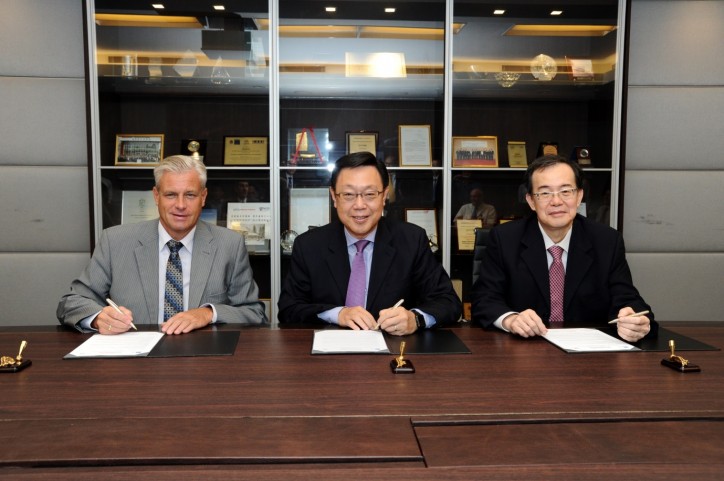Co-funded by the Maritime and Port Authority of Singapore, the project will use Lloyd’s Register’s ‘NewWave’ simulation tool and Keppel's in-house semi-submersible model test data to develop "Numerical Wave Basin" in order to improve both safety and performance of new semi-submersible designs.
Lloyd’s Register Global Technology Centre in Singapore (LR GTC) and Keppel Offshore & Marine Technology Centre (KOMtech) have engaged in a joint research and development project (JDP) to develop advanced numerical simulation capabilities, using high performance computing, to predict semi-submersible behaviour in waves.

Semi-submersible drilling rig. Courtesy of Keppel Offshore and Marine Technology Centre
Lloyd’s Register (LR) has developed a numerical tool using “NewWave” which has been applied on fixed offshore structures to simulate wave-in-deck loading. Adapting this tool with KOMtech’s deepwater know-how and both parties’ strength in Computational Fluid Dynamics (CFD), the JDP aims to build advanced capability in the prediction of semi-submersible behaviour in extreme waves through development of "Numerical Wave Basin". KOMtech’s deepwater know-how and extensive in-house data from model tests carried out on semi-submersibles will be used to benchmark and validate this new developed technology.
Michael Chia, Managing Director of Keppel Offshore and Marine Technology Centre, said: ‘Our collaboration with LR is part of KOMtech’s continuous efforts to collaborate with industry partners to develop more robust and safe solutions that can benefit all our stakeholders. In this partnership with LR, we will utilise state-of-the-art numerical modelling capabilities to provide more effective analysis to improve semi-submersible designs, thereby helping to ensure safer operations in deeper waters and harsher environments.’
‘This joint project showcases the strength and capabilities of LR and Keppel in Singapore. By using innovative digital technology and high performance computing to push the conventional design boundaries, we are able to work with industry to improve safety, accuracy and new approaches to product development and validation.’ commented Piet Mast, Regional Marine Director, Lloyd’s Register.
The project is co-funded by Maritime and Port Authority of Singapore (MPA) under the Maritime Innovation and Technology Fund.
Mr Toh Ah Cheong, MPA’s Director of Technology said, “We are pleased to see two major maritime industry players combining their Research and Development (R&D) efforts to develop a state-of-the-art numerical modelling tool for offshore structure design process. MPA looks forward to supporting more of such industry collaborations to enable the maritime industry to build up R&D capabilities and develop new solutions to advance maritime technology and engineering.”
The accurate prediction of motion and air gap requirements, between maximum wave height and the underside of a platform deck, for the design of deep water semi-submersible platforms for operations in harsh environments and extreme weather conditions is crucial. This is especially the case for operations in areas such as the Arctic, North Sea and Western Australia and other deep sea frontiers.
 Semi-submersible drilling rig (CFD modelling). Courtesy of Keppel Offshore and Marine Technology Centre
Semi-submersible drilling rig (CFD modelling). Courtesy of Keppel Offshore and Marine Technology Centre
Keppel Offshore & Marine is a leader in the design and construction of deepwater rigs and is the only global offshore and marine group to possess a suite of in-house designs.
Real ocean states are complex and difficult to define numerically due to their irregular wave patterns, strong non-linearity and non-Gaussian statistics. This is further complicated by the response of the floating body to the actual wave, making the accurate prediction of the required motion and air gap for the safe operation of a semi-submersible a real challenge.
Current methods make use of model testing to help resolve these issues. This method is time-consuming and requires multiple test runs in attempts to fully capture all possible combinations of the waves and headings. This numerical method allows fast and efficient way for simulating these conditions.

From left above : Mr. Piet Mast (Regional Marine Manager – Lloyd’s Register) ; Mr. Michael Chia (Managing Director – Keppel Offshore & Marine) ; Mr Toh Ah Cheong (Technology Director, MPA Singapore)

From left : Mr. Piet Mast (Regional Marine Manager – Lloyd’s Register) ; Mr. Michael Chia (Managing Director – Keppel Offshore & Marine) ; Mr Toh Ah Cheong (Technology Director, MPA Singapore)
Source: MPA